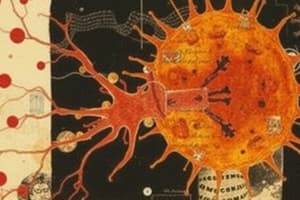Podcast
Questions and Answers
What is atrophy primarily caused by?
What is atrophy primarily caused by?
- Enhanced blood flow
- Increased work demands on the cell
- Increased nutritional intake
- Decreased work demands on the cell (correct)
Disuse atrophy can occur in muscles that are immobilized for an extended period.
Disuse atrophy can occur in muscles that are immobilized for an extended period.
True (A)
List one cause of atrophy.
List one cause of atrophy.
Disuse, denervation, endocrine hypo-function, inadequate nutrition, ischemia
Atrophy may lead to a decrease in both the size and number of __________.
Atrophy may lead to a decrease in both the size and number of __________.
Match the type of atrophy to its example:
Match the type of atrophy to its example:
Flashcards are hidden until you start studying
Study Notes
Atrophy Overview
- Atrophy involves a decrease in cell size and number due to reduced work demands.
- The body strives for efficiency, leading to decreased cellular function and energy conservation when tasks diminish.
Cellular Changes
- Atrophied cells consume less oxygen.
- Organelles within atrophied cells decrease in size and number, reflecting overall reduced cellular activity.
Causes of Atrophy
- Disuse: Occurs when muscles are not engaged, such as in immobilization due to fractures.
- Denervation: Muscle shrinkage follows paralysis, leading to loss of function.
- Endocrine hypo-function: Hormonal deficiencies, like reduced estrogen in postmenopausal women, cause organ shrinkage (notably ovaries).
- Inadequate nutrition: Lack of essential nutrients leads to cell shrinkage, comparable to withholding water and fertilizer from a plant.
- Ischemia: Insufficient blood supply affects cellular health and maintenance, leading to atrophy.
Examples of Atrophy
- Disuse atrophy: Notable in limbs immobilized in casts for extended periods.
- Denervation atrophy: Observed in muscles of paralyzed limbs.
- Endocrine-related atrophy: Seen in reproductive organs of postmenopausal women due to hormonal changes and reduced blood flow.
Studying That Suits You
Use AI to generate personalized quizzes and flashcards to suit your learning preferences.




